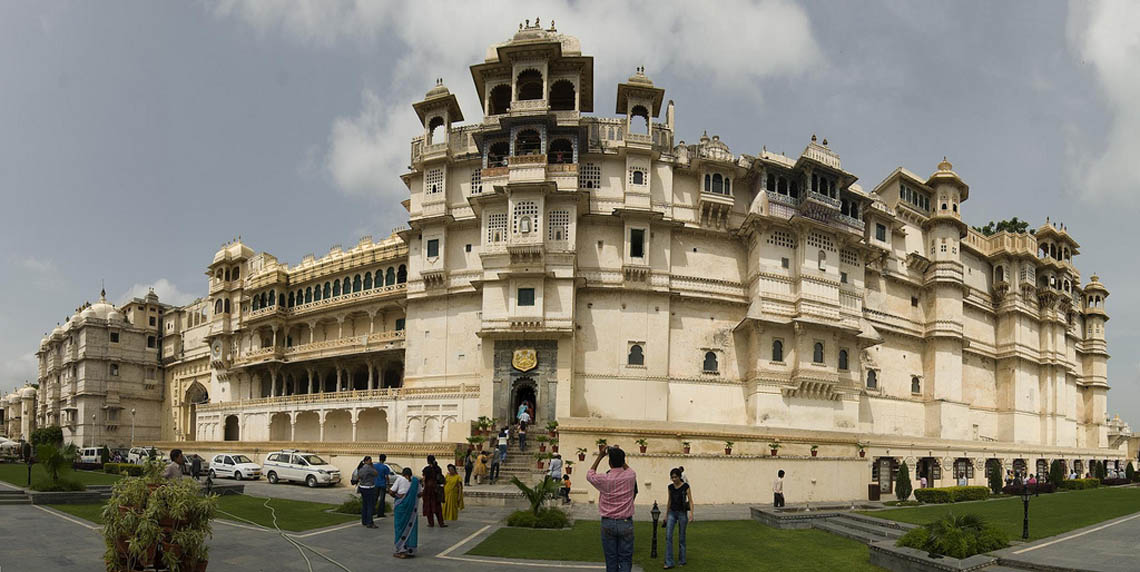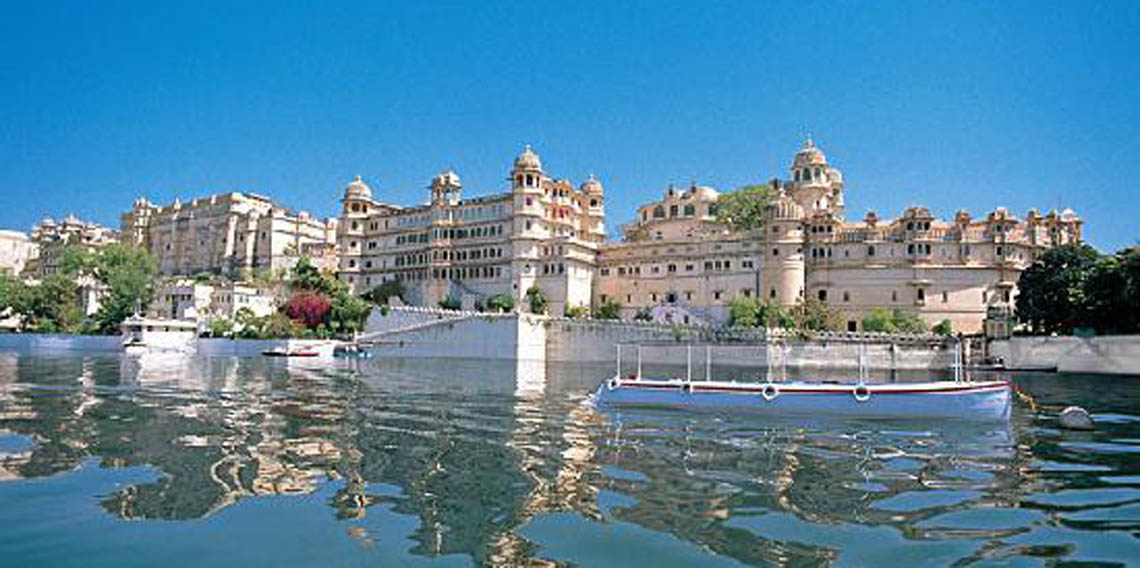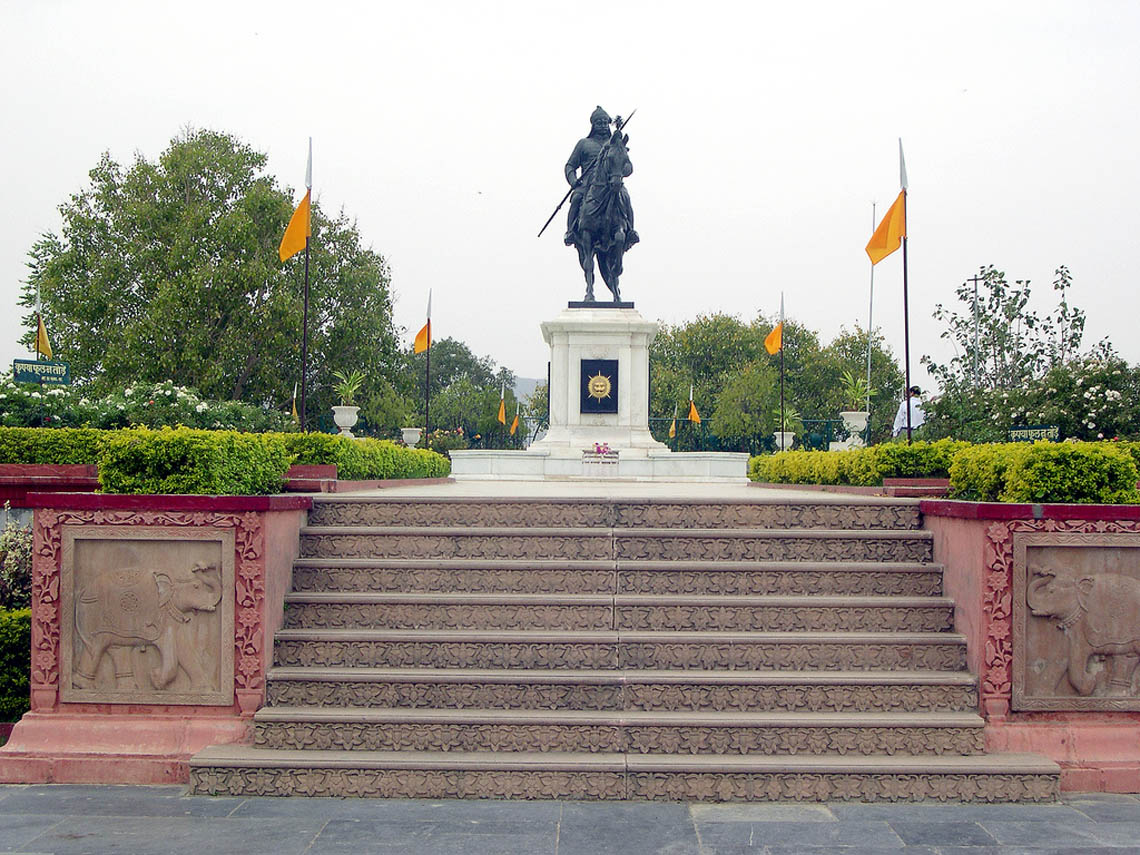Udaipur is also referred to as the "Venice of the East", the "Most Romantic City of India" and the "Kashmir of Rajasthan". Udaipur the “City of Lakes” is one among the most romantic and most beautiful cities of India. The city of Dawn, Udaipur is a lovely land around the azure water lakes, hemmed in by the lush hills of the Aravalis. A vision in white drenched in romance and beauty, Udaipur city of Rajasthan state is a fascinating blend of sights, sounds and experiences - an inspiration for the imagination of the poets, painters and writers.
Attractions:

City Palace: is a palace complex in Udaipur, in the Indian state Rajasthan. It was built by the Maharana Udai Singh as the capital of the Sisodia Rajput clan in 1559, after he moved from Chittor. It is located on the east bank of the Lake Pichola and has several palaces built within its complex. Udaipur was the historic capital of the former kingdom of Mewar in the Rajputana Agency and its last capital. The City Palace in Udaipur was built in a flamboyant style and is considered the largest of its type in Rajasthan, a fusion of the Rajasthani and Mughal architectural styles, and was built on a hill top that gives a panoramic view of the city and its surrounding, including several historic monuments such as the Lake Palace in Lake Pichola, the Jag Mandir on another island in the lake, the Jagdish Temple close to the palace, the Monsoon Palace on top of an overlooking hillock nearby and the Neemach Mata temple. These structures are linked to the filming of the James Bond movie Octopussy, which features the Lake Palace and the Monsoon Palace.

Lake Pichola: situated in Udaipur city in the Indian state of Rajasthan, is an artificial fresh water lake, created in the year 1362 AD, named after the nearby Picholi village.[1][2] It is one of the several contiguous lakes, and developed over the last few centuries in and around the famous Udaipur city. The lakes around Udaipur were primarily created by building dams to meet the drinking water and irrigation needs of the city and its neighborhood. Two islands, Jag Niwas and Jag Mandir are located within Pichola Lake, and have been developed with several palaces to provide views of the lake.

Jag Mandir: is a palace built on an island in the Lake Pichola. It is also called the "Lake Garden Palace". The palace is located in Udaipur city in the Indian state of Rajasthan. Its construction is credited to three Maharanas of the Sisodia Rajputs of Mewar kingdom. The construction of the palace was started in 1551 by Maharana Amar Singh, continued by Maharana Karan Singh (1620–1628) and finally completed by Maharana Jagat Singh I (1628–1652). It is named as "Jagat Mandir" in honour of the last named Maharana Jagat Singh. The royal family used the palace as a summer resort and pleasure palace for holding parties. The palace served as a refuge to asylum seekers on two separate occasions.

The Monsoon Palace(Sajjan Garh Palace): is a hilltop palatial residence in the city of Udaipur, Rajasthan in India, overlooking the lake Fateh Sagar. It is named as Sajjangarh after Maharana Sajjan Singh (1874–1884) of the Mewar Dynasty, who built it in 1884. It offers a panoramic view of the city's lakes, palaces and surrounding countryside. It was built basically to watch the monsoon clouds; hence, appropriately, it is popularly known as Monsoon Palace. It is said that the Maharana built it at the top of the hill to get a view of his ancestral home of Chittaurgarh. Previously owned by the Mewar royal family, it is now under the control of the Forest Department of the Government of Rajasthan and has been opened to the public recently. The palace provides a beautiful view of the sunset.

Fatah Sagar Lake: is situated in Udaipur city in the Indian state of Rajasthan. Said to be the pride of the City of Lakes of Udaipur, it is an artificial lake constructed by Maharana in north of Lake Pichola in 1680s and to the north-west of Udaipur.It is one of the four lakes of the Udaipur city; the other three lakes are: the Lake Pichola (within the Udaipur town), Udai Sagar Lake (13 km to the east of Udaipur) and Dhebar Lake or Jaisamand Lake (52 km south east of Udaipur).[1][2]Within the confines of the Fatah Sagar Lake, there are three small islands.; the largest of these is the island called the Nehru Park (4 km2 area), which is a popular garden with a restaurant and a zoo, the second island (0.06 km2 area) houses a public park with an impressive water-jet fountain and the third island (1.2 km2 area) is the address for the Udaipur Solar Observatory (USO). The Nehru park is accessed by inboard motor boats from the bottom of Moti Magri. Blue waters of the lake and the backdrop of green has given the soubriquet of ‘the second Kashmir’ to Udaipur town.

Jagdish Temple: is a large Hindu temple in the middle of Udaipur in Rajasthan. A big tourist attraction, the temple was originally called the temple of Jagannath Rai but is now called Jagdish-ji. It is a major monument in Udaipur. The Jagdish Temple is raised on a tall terrace and was completed in 1651. It attaches a double-storey Mandapa (hall) to a double-story saandhara (with a covered ambulatory) sanctum. The mandapa has another storey tucked within its pyramidal samavarna (bell-roof) while the hollow clustered spire over the sanctum contains two more, nonfunctional stories.

Saheliyon-ki-Bari (Courtyard of the Maidens): is a major garden and a popular tourist space in Udaipur in Indian state of Rajasthan. It lies in northern part of the city and has fountains and kiosks, a lotus pool and marble elephants. It was built by Maharana Bhopal Singh. Saheliyon ki Bari means Garden of the Maidens. There is also a small museum here.Sahelion Ki Bari' was laid for a group of forty-eight young women attendants who accompanied a princess to Udaipur as part of her dowry. The gardens set below the embankment of the Fateh Sagar Lake have beautiful lotus pools, marble pavilions and elephant- shaped fountains. These fountains are fed by the water of the lake gushing through ducts made for the purpose. Each water channel has its distinct sound and the mingling of these sounds complement the ambience of the place Near to saheliyon-ki-bari is burhani nagar and burhani masjid,vidhiya bhawan school and seva mandir marg.Saheliyon Ki Bari is one the most beautiful gardens and a major tourist destination in Udaipur. The garden is famous for its lush green lawns, marble art and fountains. English translation of Saheliyon Ki Bari means "Garden of maids". This renowned garden is located on the banks of Fateh Sagar Lake, presenting a green retreat in the dry lands of Rajasthan. Garden of maids was built in the 18th century by Maharana Sangram Singh for the royal ladies.

Shiv Niwas Palace: Located to the south side of and part of the City Palace complex, work on this building was begun by Maharana Sajjan Shambhu Singh (1874 to 1884) and finished by his successor Maharana Fateh Singh at the beginning of the 20th century as a royal guesthouse.During its time as a guesthouse it hosted a number of royal gatherings and VIP visits from all over the world, including George V of the United Kingdom in 1905, and Edward the Prince of Wales.By the time that Bhagwat Singh succeeded to the throne of Mewar in 1955, it was becoming increasing difficult for the royal family to afford the cost of maintaining the large numbers of royal residences that they owned, in particular the city palace. Following his success in converting the Lake Palace into an income generating hotel he decided to also convert the Shiv Niwas and the smaller Fateh Prakash Palace into luxury heritage hotels. After a 4 year long period of conversion the Shiv Niwas opened as a hotel in 1982.

Gulab Bagh :was started by Maharana Sajjan Singh in the 1878. It is the fourth oldest zoo in the semi-continent. By Maharana's volition, a horticulturist from Madras, T.H. Story, was appointed in 1882 to stock the garden with plants with medicinal values on the 66.5 acres of land and worked there till 1920. The garden consisted of a Lotus Pond, and many prominent trees that included many species of mangoes, guava, grapes, lemon, bor, mulbury, rayan, pomegranate, bananas, sapota, tamarind, bullock’s heart (ramphal), lichi, arjun trees, wood apple, karonda, campher, citron, jamun, pummelo, meetha neem, kargi lime, ficus species, anola, jack fruit, dhanverjia, grandi flora, jasmin, dawood etc. In the year 1882, all the trees had their name-plates denoting Hindi, English, and systematic botanical names, which are not the same now. A small pond existed in the garden before it was demolished for the construction of Water works complex. In this pond a water lily, Victoria sp., was initially planted. The leaf of Victoria could withstand a child on a chair kept on it, a property common to all the water-lilies of the genus due to plant's structure.

Moti Magri:overlooks the Fateh Sagar Lake in the city of Udaipur, Rajasthan.Atop the Moti Magri or Pearl Hill is the memorial of the Rajput hero Maharana Pratap, which has a bronze statue of the Maharana astride his favourite horse "Chetak"


